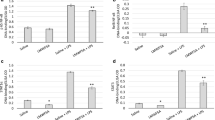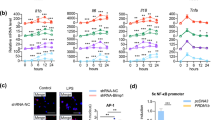Abstract
Inflammation was the important pathological process of many disease developments, but current therapeutic means for inflammatory diseases are not satisfactory. Chemokines and their receptors represent valuable targets for anti-inflammatory drug discovery. The N15P polypeptide (sequence: LGASWHRPDKCCLGY) is independently developed by our research group, it is a new CXCR4 antagonist drug derived from viral macrophage inflammatory protein-II (vMIP-II). This study aims to clarify the anti-inflammatory potency of N15P polypeptide on the lipopolysaccharide (LPS)-induced inflammation in vitro. In this study, we evaluated the anti-inflammatory effects of N15P polypeptide by the LPS-induced peripheral blood mononuclear cell (PBMC) model and measured the level of inflammatory factors (tumor necrosis factor alpha (TNF-α), IL-6, IL-8, nuclear factor kappaB (NF-κB), cyclooxygenase-2 (COX-2), Toll-like receptor 4 (TLR4), MyD88, phosphoinositide 3-kinase (PI3K), and Akt). The messenger RNA (mRNA) expressions of inflammatory factors were analyzed by real-time PCR (RT-PCR) microarray analysis, and the production of inflammatory factors was measured further by enzyme-linked immunosorbent assay (ELISA) and Western blot. The results showed that the expression of inflammatory factors (TNF-α, IL-6, IL-8, NF-κB, COX-2, TLR4, MyD88, PI3K, and Akt) was downregulated by N15P peptide, suggesting that N15P peptide has a strong inhibitory effect on the inflammatory responses induced by LPS.




Similar content being viewed by others
References
Kundu, J.K., and Y.J. Surh. 2008. Inflammation: Gearing the journey to cancer. Mutation Research 659: 15–30.
Bieghs, V., and C. Trautwein. 2013. The innate immune response during liver inflammation and metabolic disease. Trends in Immunology 34(9): 446–452.
Lichtenberger, L.M., Y. Zhou, V. Jayaraman, J.R. Doyen, R.G. O’Neil, E.J. Dial, D.E. Volk, D.G. Gorenstein, M.B. Boggara, and R. Krishnamoorti. 2012. Insight into NSAID-induced membrane alterations, pathogenesis and therapeutics: Characterization of interaction of NSAIDs with phosphatidylcholine. Biochimica et Biophysica Acta 1821: 994–1002.
Niranjan, R., R. Manik, A.K. Srivastava, G. Palit, and S.M. Natu. 2011. Cardiovascular side effect remotely related to NSAIDs: A comparative experimental study on albino rats. Journal of Anatomical Society of India 60(2): 155–159.
Mortier, A., J.V. Damme, and P. Proost. 2012. Overview of the mechanisms regulating chemokine activity and availability. Immunology Letters 145: 2–9.
Gouwy, M., M. Schiraldi, S. Struyf, J.V. Damme, and M. Uguccioni. 2012. Possible mechanisms involved in chemokine synergy fine tuning the inflammatory response. Immunology Letters 145: 10–14.
Klarenbeek, A., D. Maussang, C. Blanchetot, M. Saunders, S.V.D. Woning, M. Smit, H.D. Haard, and E. Hofman.2012. Targeting chemokines and chemokine receptors with antibodies. Drug Discovery Today: Technologies 9: 237–244.
Bonavia, R., A. Bajetto, S. Barbero, P. Pirani, T. Florio, and G. Schettini. 2003. Chemokines and their receptors in the CNS: Expression of CXCL12/SDF-1 and CXCR4 and their role in astrocyte proliferation. Toxicology Letters 139: 181–189.
Penn, M.S. 2010. SDF-1:CXCR4 Axis is fundamental for tissue preservation and repair. The American Journal of Pathology 177(5): 2166–2168.
Tan, J.Q., H.H. Jacobi, J. Chen, C.M. Reimert, Q. Sha, S. Dissing, L.K. Poulsen, and P.S. Skov. 2000. Chemokine stromal cell-derived factor 1α activates basophils by means of CXCR4. Allergy and Clinical Immunology 106(2): 313–320.
Allegretti, M., M.C. Cesta, A. Garin, and A.E. Proudfoot. 2012. Current status of chemokine receptor inhibitors in development. Immunology Letters 145: 68–78.
Szpakowska, M., V. Fievez, K. Arumugan, N.V. Nuland, J.C. Schmit, and A. Chevigne. 2012. Function, diversity and therapeutic potential of the N-terminal domain of human chemokine receptors. Biochemical Pharmacology 84: 1366–1380.
Arvanitakis, L., E.R. Geras, A. Varma, M.C. Gershengorn, and E. Cesarman. 1997. Human herpesvirus KSHV encodes a constitutively active G-protein-coupled receptor linked to cell proliferation. Nature 385: 347–350.
Moore, P.S., C. Boshoff, R.A. Wiess, and Y. Chang. 1996. Molecular mimicry of human cytokine and cytokine response pathway genes by KSHV. Science 274: 1739–1744.
Dittmer, D., and D.H. Kedes. 1998. Do viral chemokines modulate Kaposi’s sarcoma? Bioessays 20: 367–370.
Kanbara, K., N. Fujii, and H. Nakashima. 2000. A study of anti-HIV compounds which interfere with the virus entry via coreceptor CXCR4. The Journal of the Japanese Association for Infectious Diseases 74: 237–244.
Boshoff, C., Y. Endo, P.D. Collins, Y. Takeuchi, J.D. Reeves, V.L. Schweickart, M.A. Siani, T. Sasaki, T.J. Williams, P.W. Gray, P.S. Moore, Y. Chang, and R.A. Weiss. 1997. Angiogenic and HIV-inhibitory functions of KSHV-encoded chemokines. Science 278: 290–294.
H.X. Sun. 2006. CXCR4 receptor antagonist peptides derived from viral macrophage inflammatory protein and its application. China Patent NO.CN1872879B (ZL 200610036137.8).
Bradford, M.M. 1976. A rapid and sensitive method for quantitation of microgram quantities of protein utilizing the principle of protein-dye binding. Analytical Biochemistry 72: 248–254.
Livak, K.J., and T.D. Schmittgen. 2001. Analysis of relative gene expression data using real-time quantitative PCR and the 2−∆∆Ct method. Methods 25: 402–408.
Rainsford, K.D. 1999. Profile and mechanisms of gastrointestinal and other side effects of nonsteroidal anti-inflammatory drugs (NSAIDs). The American Journal of Medicine 107(6): 27–35.
Lazennec, G., and A.Richmond. 2010. Chemokines and chemokine receptors: new insights into cancer-related inflammation. Trends in Molecular Medicine 6: 133–144.
Kleine, T.O., P. Zwerenz, C. Graser, and P. Zöfel. 2003. Approach to discriminate subgroups in multiple sclerosis with cerebrospinal fluid (CSF) basic inflammation indices and TNF-α, IL-1β, IL-6, IL-8. Brain Research Bulletin 42: 327–346.
Hashizume, M., and M. Mihara. 2012. Atherogenic effects of TNF-a and IL-6 via up-regulation of scavenger receptors. Cytokine 58: 424–430.
Fitzgerald, K.A., D.C. Rowe, and D.T. Golenbock. 2004. Endotoxin recognition and signal trans-duction by the TLR4/MD2-complex. Microbes and Infection 6: 1361–1367.
Yamamoto, M., S. Sato, H. Hemmi, S. Uematsu, K. Hoshino, and T. Kaisho. 2003. TRAM is specifically involved in the Toll-like receptor 4-mediated MyD88-independent signaling pathway. Nature Immunology 4: 1144–1150.
Ren, W.Y., L.J. Hu, F. Hua, J.J. Jin, Y.Y. Wang, and L. Zhu. 2001. Myeloid differentiation protein 2 silencing decreases LPS-induced cytokine production and TLR4/MyD88 pathway activity in alveolar macrophages. Immunology Letters 141: 94–101.
Kawai, T., and S. Akira. 2007. Signaling to NF-kappaB by Toll-like receptors. Trends in Molecular Medicine 13: 460–469.
Everhart, M.B., W. Han, T.P. Sherrill, M. Arutiunov, V.V. Polosukhin, and J.R. Burke. 2006. Duration and intensity of NF-kappaB activity determine the severity of endotoxin-induced acute lung injury. Journal of Immunology 176: 4995–5005.
Wu, J.F., J.M. Zhou, X.G. Chen, N. Fortenbery, E.A. Eksioglu, S. Wei, and J.C. Dong. 2012. Attenuation of LPS-induced inflammation by ICT, a derivate of icariin, via inhibition of the CD14/TLR4 signaling pathway in human monocytes. International Immunopharmacology 12: 74–79.
Smith, W.L., D.L. DeWitt, and R.M. Garavito. 2000. Cyclooxygenases: Structural, cellular and molecular biology. Annual Review of Biochemistry 69: 145–182.
McEvoy, A.N., B. Bresnihan, O. FitzGerald, and E.P. Murphy. 2004. Cyclooxygenase 2-derived prostaglandin E2 production by corticotropin-releasing hormone contributes to the activated cAMP response element binding protein content in rheumatoid arthritis synovial tissue. Arthritis and Rheumatism 50: 1132–1145.
Ebersberger, A., B.D. Grubb, H.L. Willingale, N.J. Gardiner, J. Nebe, and H.G. Schaible. 1999. The intraspinal release of prostaglandin E2 in a model of acute arthritis is accompanied by an upregulation of cyclooxygenase-2 in the spinal cord. Neuroscience 93: 775–781.
Guay, J., K. Bateman, R. Gordon, J. Mancini, and D. Riendeau. 2004. Carrageenan-induced paw edema in rat elicits a predominant prostaglandin E2 (PGE2) response in the central nervous system associated with the induction of microsomal PGE2 synthase-1. Journal of Biological Chemistry 279: 24866–24872.
Toriyabe, M., K. Omote, T. Kawamata, and A. Namiki. 2004. Contribution of interaction between nitric oxide and cyclooxygenases to the production of prostaglan-dins in carrageenan-induced inflammation. Anesthesiology 101: 983–990.
Acknowledgments
This work was supported by funding from the National Natural Science Foundation of China (no. 30872221), the Foundation for Distinguished Young Talents in Higher Education of Guangdong Province (no. 2012LYM-0023), the Medicine Science and Technology Research Foundation of Guangdong Province (no. B2012198), the Science and Technology Foundation of Administration of Traditional Chinese Medicine of Guangdong Province (no. 20131153), and the Fundamental Research Funds for the Central Universities (no. 21613340).
Author information
Authors and Affiliations
Corresponding author
Rights and permissions
About this article
Cite this article
Xue-mei, M., Han-xiao, S. The Anti-inflammatory Effect of the CXCR4 Antagonist-N15P Peptide and Its Modulation on Inflammation-Associated Mediators in LPS-Induced PBMC. Inflammation 38, 1374–1383 (2015). https://doi.org/10.1007/s10753-015-0109-1
Published:
Issue Date:
DOI: https://doi.org/10.1007/s10753-015-0109-1




